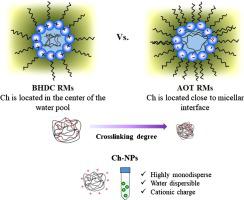当前位置:
X-MOL 学术
›
Colloids Surf. A Physicochem. Eng. Aspects
›
论文详情
Our official English website, www.x-mol.net, welcomes your
feedback! (Note: you will need to create a separate account there.)
Role of micellar interface in the synthesis of chitosan nanoparticles formulated by reverse micellar method
Colloids and Surfaces A: Physicochemical and Engineering Aspects ( IF 4.9 ) Pub Date : 2020-08-01 , DOI: 10.1016/j.colsurfa.2020.124876 M. Soledad Orellano , Gabriel S. Longo , Carina Porporatto , N. Mariano Correa , R. Darío Falcone
Colloids and Surfaces A: Physicochemical and Engineering Aspects ( IF 4.9 ) Pub Date : 2020-08-01 , DOI: 10.1016/j.colsurfa.2020.124876 M. Soledad Orellano , Gabriel S. Longo , Carina Porporatto , N. Mariano Correa , R. Darío Falcone

|
Abstract Chitosan nanoparticles (Ch-NPs) have been extensively studied due to their wide applicability. The reverse micellar method has attracted special attention as a way to synthesize them, since it makes it possible to obtain size-controlled particles. This procedure involves the chitosan crosslinking reaction into polar cores of reverse micelles (RMs). Previous studies using sodium 1,4-bis-2-ethylhexylsulfosuccinate (AOT) RMs as nanoreactors showed that by changing the reagent concentration and RM water content, the final particle size can be adjusted. To gain insight into this method, we studied the effect of the micellar interface on the synthesis of Ch-NPs. Both benzyl-n-hexadecyldimethylammonium chloride (BHDC) and AOT RMs were assessed, since there are remarkable differences between their interfacial water entrapped structure. Ch-NPs were characterized by FT-IR spectroscopy, Dynamic Light Scattering, and Scanning Electron Microscopy. Simulation studies by molecular theory were also performed. On the other hand, Ch-NPs obtained under different conditions were assessed in terms of their ability to solubilize curcumin, whose numerous therapeutic properties are somewhat countered by its poor solubility in water. The results show that Ch-NPs can be obtained from AOT and BHDC RMs by the reverse micellar method. The crosslinking reaction takes place in the micellar interface, and is more effective in AOT RMs. This difference in effectiveness can be attributed to the different positions Ch acquires in each of the two RMs tested. Finally, the NPs notably enhance the water solubility of curcumin, and particle size is the main determining factor for encapsulation efficiency.
中文翻译:

胶束界面在反胶束法合成壳聚糖纳米粒子中的作用
摘要 壳聚糖纳米粒子 (Ch-NPs) 由于其广泛的适用性而被广泛研究。反胶束法作为合成它们的一种方式引起了特别关注,因为它可以获得尺寸控制的颗粒。此过程涉及壳聚糖交联反应进入反胶束 (RM) 的极性核心。先前使用 1,4-双-2-乙基己基磺基琥珀酸钠 (AOT) RM 作为纳米反应器的研究表明,通过改变试剂浓度和 RM 水含量,可以调整最终粒径。为了深入了解这种方法,我们研究了胶束界面对 Ch-NPs 合成的影响。对苄基-n-十六烷基二甲基氯化铵 (BHDC) 和 AOT RM 进行了评估,因为它们的界面水截留结构之间存在显着差异。Ch-NPs 通过 FT-IR 光谱、动态光散射和扫描电子显微镜进行表征。还进行了分子理论的模拟研究。另一方面,评估了在不同条件下获得的 Ch-NPs 溶解姜黄素的能力,姜黄素的许多治疗特性在某种程度上因其在水中的溶解度差而受到抵消。结果表明,可以通过反胶束法从 AOT 和 BHDC RM 中获得 Ch-NP。交联反应发生在胶束界面,在 AOT RMs 中更有效。这种有效性差异可归因于 Ch 在测试的两个 RM 中的每一个中获得的不同位置。最后,NPs 显着提高姜黄素的水溶性,粒径是包封效率的主要决定因素。
更新日期:2020-08-01
中文翻译:

胶束界面在反胶束法合成壳聚糖纳米粒子中的作用
摘要 壳聚糖纳米粒子 (Ch-NPs) 由于其广泛的适用性而被广泛研究。反胶束法作为合成它们的一种方式引起了特别关注,因为它可以获得尺寸控制的颗粒。此过程涉及壳聚糖交联反应进入反胶束 (RM) 的极性核心。先前使用 1,4-双-2-乙基己基磺基琥珀酸钠 (AOT) RM 作为纳米反应器的研究表明,通过改变试剂浓度和 RM 水含量,可以调整最终粒径。为了深入了解这种方法,我们研究了胶束界面对 Ch-NPs 合成的影响。对苄基-n-十六烷基二甲基氯化铵 (BHDC) 和 AOT RM 进行了评估,因为它们的界面水截留结构之间存在显着差异。Ch-NPs 通过 FT-IR 光谱、动态光散射和扫描电子显微镜进行表征。还进行了分子理论的模拟研究。另一方面,评估了在不同条件下获得的 Ch-NPs 溶解姜黄素的能力,姜黄素的许多治疗特性在某种程度上因其在水中的溶解度差而受到抵消。结果表明,可以通过反胶束法从 AOT 和 BHDC RM 中获得 Ch-NP。交联反应发生在胶束界面,在 AOT RMs 中更有效。这种有效性差异可归因于 Ch 在测试的两个 RM 中的每一个中获得的不同位置。最后,NPs 显着提高姜黄素的水溶性,粒径是包封效率的主要决定因素。






























 京公网安备 11010802027423号
京公网安备 11010802027423号